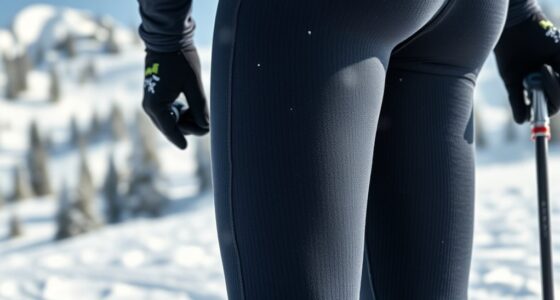If you’re looking for the top wildlife audio recorders for 2025, I recommend exploring options like the Zoom H4essential, TASCAM DR-40X, and specialized devices such as the Podoy Bird Listening Device. These offer high sound quality, long-range listening, and durable designs perfect for outdoor use. Trail cameras with night vision and connectivity also enhance wildlife capture. Keep exploring to find out more about the best tools to document nature’s sounds effectively.
Key Takeaways
- The list features portable, high-fidelity audio recorders suitable for capturing subtle wildlife sounds in various environments.
- It includes devices with advanced noise reduction, high SPL handling, and long recording durations for extended field sessions.
- The selection covers both professional-grade recorders and user-friendly options for amateur wildlife enthusiasts.
- Devices incorporate innovative features like 32-bit float recording, multiple formats, and external microphone support for optimal sound quality.
- The list emphasizes durability, weather resistance, and remote monitoring capabilities for effective outdoor wildlife recording.
GardePro E6 Trail Camera with WiFi, 48MP, Night Vision, Waterproof

If you’re looking for a wildlife camera that combines high-resolution imaging with reliable connectivity, the GardePro E6 Trail Camera is an excellent choice. It captures stunning 48MP still images and 1296P HD videos using advanced H.264 encoding, making previewing easy without downloading. The 110° wide-angle lens, auto-focus, and CMOS sensor ensure sharp visuals day or night. Night vision with 940nm infrared technology provides clear images up to 75 feet. Waterproof and rugged with an IP66 rating, it’s built for outdoor use. Plus, WiFi and Bluetooth allow you to control and view footage remotely via the GardePro app, adding convenience to your wildlife monitoring.
Best For: wildlife enthusiasts, hunters, and property owners seeking high-resolution camera footage with reliable remote connectivity.
Pros:
- Captures sharp 48MP images and 1296P HD videos with advanced encoding for easy previewing.
- Equipped with a wide-angle lens, auto-focus, and night vision for clear visuals day and night.
- Features WiFi and Bluetooth for convenient remote control, live view, and easy footage download via the GardePro app.
Cons:
- App performance can be sluggish, especially when handling large media files or multiple downloads.
- WiFi connectivity may disconnect from home networks, requiring direct device-to-camera setup.
- Battery life can be limited during extended night vision use without external power solutions.
Browning Trail Cameras Defender Vision Pro HD 24MP Trail Camera

The Browning Trail Cameras Defender Vision Pro HD 24MP Trail Camera stands out for outdoor enthusiasts who need high-resolution images and dependable night vision. Its 24 Megapixel camera captures crisp HD photos, while 1080p videos with MPEG-4 encoding deliver clear footage. Equipped with infrared lighting, it detects movement up to 110 feet in complete darkness. The camera’s Illuma-Smart technology adjusts IR flash for ideal night shots, and its user-friendly interface makes setup straightforward. Durable with an IP65 rating, it performs well in most weather conditions. For those wanting instant image uploads, cellular connectivity with dual SIMs ensures reliable communication, making it a versatile choice for wildlife monitoring.
Best For: outdoor enthusiasts and wildlife observers seeking high-resolution trail images with reliable night vision and cellular connectivity for instant updates.
Pros:
- High 24MP photo resolution and 1080p HD video capability for clear, detailed imagery.
- Infrared night vision with a 110-foot detection range and Illuma-Smart technology for optimal low-light photos.
- Supports cellular transmission with dual SIM cards and easy remote management via smartphone app.
Cons:
- Performance issues in temperatures near or below freezing, with some units shutting down or malfunctioning.
- Variable cellular signal strength depending on location, requiring good coverage for optimal operation.
- No coverage maps provided, making it difficult to assess cellular reliability in specific areas.
Podoy Bird Listening and Recording Device with Headphone, Long Range up to 300ft
https://m.media-amazon.com/images/I/61JaU6IVPKL._AC_SX679_.jpg
The Podoy Bird Listening and Recording Device stands out for its impressive long-range hearing capability, reaching up to 300 feet, making it ideal for bird watchers and outdoor enthusiasts who want to hear elusive sounds from a distance. It combines a powerful optical system with a digital sound amplifier and recorder, capturing 12-second audio clips without needing a SIM or SD card. Its portable size and adjustable headphones make outdoor exploration easy. However, some users report inconsistent recording functions and build quality concerns. While it offers decent live sound amplification, its performance varies, and it may require modifications for *best* use. Overall, it’s a handy tool but not foolproof.
Best For: outdoor bird watchers and nature enthusiasts seeking a portable device with long-range sound amplification and recording capabilities.
Pros:
- Long-range hearing up to 300 feet for distant sound detection
- Compact and portable design suitable for outdoor use
- Built-in recorder captures 12-second clips without additional cards
Cons:
- Inconsistent recording function and potential build quality issues
- Limited sound quality and amplification in noisy environments
- Customer feedback indicates durability concerns and variable performance
TASCAM DR-40X Portable Handheld Recorder

For wildlife enthusiasts seeking a versatile and reliable recorder, the TASCAM DR-40X stands out thanks to its dual XLR/TRS inputs with phantom power, allowing me to connect external microphones for enhanced sound quality. It’s a 4-channel portable device with adjustable internal mics in A-B and X-Y configurations, capturing clear stereo recordings. Its onboard mics are great for discreet setups, while external mic options suit interviews or field recordings. Lightweight and easy to operate, it records in WAV and MP3 formats, making it perfect for capturing nature sounds, sermons, or events. Its durability, long battery life, and dual recording features make it a trusted choice for serious wildlife recording.
Best For: wildlife enthusiasts, field recorders, and nature sound collectors seeking a portable, versatile device with high-quality audio input options and reliable performance.
Pros:
- Equipped with dual XLR/TRS inputs with phantom power for external microphone flexibility
- Offers adjustable internal microphones in A-B and X-Y configurations for versatile stereo recording
- Durable, lightweight design with long battery life suitable for extended field sessions
Cons:
- May have a learning curve due to its multiple features and settings
- Documentation and user manual could be more comprehensive for new users
- External power sources are recommended for very long recordings, as batteries may not last through extended sessions
Bird Recording and Listening Device with 5-Hour Long Range Bionic Ear Electronic Listening

If you’re looking to observe birds and wildlife from a distance, the Bird Recording and Listening Device with 5-hour long-range Bionic Ear makes it possible to see and hear animals within 320 feet. This device is perfect for birdwatchers, hobbyists, or researchers wanting to explore nature’s sounds. It offers over five hours of continuous recording, high-definition imaging with 8x magnification, and a powerful sound amplification system. Its ergonomic design makes it easy to operate with one hand, and it’s lightweight. Keep in mind, background noise can be amplified, so it’s best used in quiet environments for clearer results.
Best For: birdwatchers, wildlife enthusiasts, and researchers seeking to observe and record nature sounds from a distance with high-definition imaging and long-duration recording capabilities.
Pros:
- Supports over five hours of continuous sound recording with easy export options
- High-quality 8x magnification with clear, low-light imaging and adjustable focus
- Ergonomic, lightweight design for one-handed operation and ease of use in the field
Cons:
- Background noise can be significantly amplified, affecting clarity
- Some users report issues with build quality and durability over time
- Sound clarity at longer distances may be limited, impacting detailed listening
Zoom F3 2-input Field Recorder (F3Zoomd1)

When capturing the subtle nuances of wildlife sounds, clarity and reliability are essential, making the Zoom F3 2-input Field Recorder an excellent choice for serious nature recordists. Its compact design belies its professional capabilities, featuring 32-bit float recording that handles a wide dynamic range without clipping. The dual XLR inputs support various microphones, while its low self-noise ensures pristine audio. With over six hours of battery life and intuitive controls, it’s perfect for handheld or mounted use. Rugged and lightweight, the F3 offers wireless control and external power options, making it a versatile, dependable tool for capturing high-quality ambient sounds in the field.
Best For: serious wildlife recordists and outdoor sound enthusiasts seeking portable, high-quality ambient audio capture with reliable, low-noise performance.
Pros:
- Exceptional 32-bit float recording for wide dynamic range and clipping prevention
- Compact, lightweight, and rugged design ideal for field use and handheld recording
- Dual XLR inputs with external power options and wireless control for versatile setups
Cons:
- Only two inputs, limiting multi-mic configurations like Decca trees
- No traditional gain controls, relying solely on 32-bit float technology
- Limited phantom power output (10mA), which may not power all microphones effectively
EVISTR 64GB Digital Voice Recorder with Playback

The EVISTR 64GB Digital Voice Recorder with Playback stands out as an excellent choice for anyone seeking high-quality, straightforward audio capture in various settings. Its upgraded noise reduction microphone and PCM technology deliver crystal-clear stereo sound, even in noisy environments. With 1536kbps recording quality and a 64GB capacity, it can store thousands of hours of recordings. The simple two-button interface makes operation easy, and features like voice activation and scheduled auto-recording add convenience. Compact, durable, and with long battery life, it’s perfect for fieldwork, meetings, or personal notes. While performance drops at longer distances, its portability and ease of use make it a reliable tool for capturing clear, detailed sounds nearby.
Best For: individuals seeking a reliable, high-capacity digital voice recorder for meetings, lectures, interviews, or personal notes with easy operation and excellent sound quality.
Pros:
- Exceptional audio quality with upgraded noise reduction and PCM technology for clear stereo recordings
- Large 64GB storage capacity supporting thousands of hours of recordings
- User-friendly two-button interface with automatic file management and versatile playback options
Cons:
- Performance diminishes at longer distances, making it less ideal for distant recording scenarios
- Small screen and controls may be challenging for some users to navigate
- Limited detailed instructions in the manual, requiring users to seek additional online resources
Zoom H1essential Stereo Recorder with Microphones

The Zoom H1essential Stereo Recorder stands out for its 32-bit float recording capability, making it an excellent choice for wildlife enthusiasts who want consistent high-quality audio without fussing over gain settings. Its built-in X/Y condenser microphones handle sound levels up to 120 dB SPL, capturing everything from quiet whispers to loud calls. With support for up to 96kHz sample rates, it delivers professional-grade fidelity. Its compact, durable design makes it perfect for field use, and it doubles as a USB microphone for easy file transfer. Whether outdoors or in the studio, this recorder offers versatility and reliable performance for capturing nature’s sounds.
Best For: wildlife enthusiasts, field recorders, and content creators seeking high-quality, portable audio capture without complex setup.
Pros:
- 32-bit float recording simplifies gain management, ensuring consistent audio quality in varying environments
- Compact, durable design ideal for outdoor and on-the-go use
- Supports high sample rates up to 96kHz for professional-grade audio fidelity
Cons:
- Sensitive to handling noise, requiring external accessories for optimal outdoor recording
- Requires microSD cards (sold separately) for storage, adding to overall cost
- External microphones or accessories may be needed for best sound quality, increasing setup complexity
Elasound Voice Recorder with AI Noise Reduction (132G, 9800H)

If you’re seeking a wildlife audio recorder that can handle long-term sessions without frequent data transfers, the Elasound Voice Recorder with AI Noise Reduction (132G, 9800H) stands out thanks to its massive 128GB storage capacity and impressive 9800 hours of recording at 32kbps. It supports continuous recording up to 100 hours on a full charge and automatically saves recordings when the battery is low, preventing data loss. Featuring AI-Intelligent Triple Noise Cancellation, it delivers clear audio even in noisy environments. Its simple one-touch operation, USB-C quick transfer, and portability make it ideal for capturing nature’s sounds discreetly and reliably over extended periods.
Best For: wildlife enthusiasts, researchers, and nature recorders seeking long-term, high-quality audio capture in noisy outdoor environments.
Pros:
- Massive 128GB storage capacity supporting up to 9800 hours of audio, ideal for extended field recordings
- Equipped with AI-Intelligent Triple Noise Cancellation for clear sound even amid environmental noise
- Simple one-touch operation and portable design with accessories for discreet and convenient recording
Cons:
- Slightly larger size compared to ultra-compact recorders, which may affect discreetness in some scenarios
- Requires a TF card for maximum storage, adding an extra step for initial setup
- Battery life, while substantial, still limits continuous recording to about 100 hours, necessitating careful management for very long sessions
64GB Digital Voice Recorder with Playback

For wildlife enthusiasts seeking a reliable recorder with playback capabilities, the GB Digital Voice Recorder with Playback stands out thanks to its generous 64GB storage and impressive 100-hour battery life. It includes a 64GB TF card and supports expandable storage up to 4,552 hours of audio at 32kbps. The device offers high-quality 3072kbps HD audio, dual microphones for stereo recording, and PCM noise reduction for clarity. Its rechargeable battery ensures long sessions, and on-device file management makes organizing recordings easy. Plus, features like voice activation, variable speed playback, and fast transfer via USB-C make it a versatile tool for capturing and reviewing nature’s sounds effortlessly.
Best For: wildlife enthusiasts and nature recorders seeking a portable, long-lasting device with high-quality audio playback and easy file management.
Pros:
- Large 64GB storage capacity with support for up to 4,552 hours of audio at 32kbps.
- High-quality 3072kbps HD audio with dual microphones and PCM noise reduction for clear recordings.
- Long battery life of up to 100 hours and convenient features like voice activation and fast USB-C transfer.
Cons:
- Internal microphone and speakers are of poor quality; external microphone recommended.
- Some users report device malfunctions, build quality issues, and unreliable SD card sockets.
- Small controls and internal microphone may limit usability for professional or distant recordings.
TASCAM DR-10L Pro Field Recorder with Lavalier Microphone

When selecting a wildlife audio recorder, capturing clear, natural sounds without drawing attention is essential. The TASCAM DR-10L Pro is a compact, lightweight device with a lavalier microphone, perfect for discreet recording. Its 32-bit float technology handles a wide dynamic range, ensuring high-quality audio from whispers to loud sounds. Supporting microSDXC cards up to 512GB, it offers hours of storage. With features like LTC Jam Sync and wireless timecode support, it’s versatile for multi-device setups. Its intuitive interface, long battery life, and excellent sound clarity make it ideal for fieldwork, interviews, and capturing nature’s subtle sounds effortlessly.
Best For: wildlife researchers and outdoor audio enthusiasts seeking discreet, high-quality sound capture in challenging environments.
Pros:
- Compact and lightweight design for easy concealment in natural settings
- Supports 32-bit float recording to capture a wide dynamic range without clipping
- Long battery life and large storage capacity for extended field recordings
Cons:
- Some users report initial setup complexity and software activation issues
- Internal battery may require internal charging to retain date/time long-term
- Inconsistent SD card reading and potential device reliability concerns for some users
BLAZEVIDEO 2-Pack Game & Trail Camera

The BLAZEVIDEO 2-Pack Game & Trail Camera stands out for wildlife enthusiasts and outdoor adventurers seeking reliable, high-quality imaging in the field. It captures sharp 64MP photos and clear 1296P videos, supports up to 512GB SD cards, and features a 110° wide-angle view with auto-focus. The camera’s infrared night vision, with no glow LEDs and an IR range of up to 75 feet, ensures discreet monitoring. Its quick 0.3-second trigger response, motion detection up to 75 feet, and durable IP66 construction make it dependable in all weather conditions. Easy to set up and operate, it’s ideal for wildlife tracking, security, and outdoor surveillance.
Best For: outdoor enthusiasts, wildlife observers, and security users seeking high-resolution, durable trail cameras for all-weather outdoor monitoring.
Pros:
- Captures sharp 64MP photos and 1296P videos for high-quality imaging
- Fast 0.3-second trigger response with 75ft detection range for reliable motion detection
- Rugged IP66 waterproof design withstands rain, dust, and temperature extremes
Cons:
- Night vision images can be dark or blurry, with IR range sometimes insufficient beyond 30-35ft
- Occasional reports of water damage or hardware malfunctions under prolonged exposure
- Some users experience issues with SD card corruption or camera disconnection when accessing the compartment
Zoom H4essential 4-Track Handy Recorder

The Zoom H4essential 4-Track Handy Recorder stands out with its 32-bit float recording technology, making it an ideal choice for wildlife enthusiasts who need reliable capture in unpredictable environments. It records up to 96kHz on SD cards and features stereo XY microphones that handle sounds up to 130 dB SPL. Its high-definition converters ensure high fidelity, while the built-in microphones deliver clear, detailed audio. External mics like shotgun or condenser options are compatible too. The device’s intuitive interface and tactile controls make it accessible, even for visually impaired users. Overall, it offers professional-quality audio in a durable, portable design perfect for field recordings.
Best For: outdoor enthusiasts, wildlife recorders, and field researchers seeking high-fidelity, portable audio capture in unpredictable environments.
Pros:
- 32-bit float recording technology reduces clipping and allows flexible post-recording level adjustments
- Durable, portable design suitable for fieldwork and outdoor use
- Supports external microphones like shotgun and condenser mics for versatile recording options
Cons:
- Slightly bulky size may be inconvenient for pocket portability
- Some interface navigation challenges due to limited file management features
- Input overload issues reported with line-in connections in certain scenarios
F6 Multitrack Field Recorder

If you’re serious about capturing high-fidelity wildlife sounds, the F6 Multitrack Field Recorder stands out thanks to its 32-bit float recording capability. This feature prevents clipping and preserves audio quality, even in dynamic environments. With six high-gain, low-noise XLR inputs and support for Ambisonics, WAV, and MP3 formats, it’s versatile and adaptable. Its rugged design and multiple power options make it perfect for field use, while its easy-to-navigate menu and high-quality preamps ensure clear, detailed recordings. Whether you’re recording distant birds or loud thunderstorms, the F6 offers professional-level sound quality in a compact, durable package.
Best For: serious field recordists, filmmakers, and wildlife sound enthusiasts seeking high-fidelity, portable audio capture with advanced features.
Pros:
- Exceptional 32-bit float recording prevents clipping and maintains audio integrity in dynamic environments
- Versatile with 6 high-gain, low-noise XLR inputs and support for Ambisonics, WAV, and MP3 formats
- Rugged, compact design with multiple power options ensures reliable use in demanding outdoor conditions
Cons:
- Small buttons can be challenging to operate precisely in the field
- Tripod screw placement at the back may affect stability when mounted
- Slightly sterile sound profile noted by some users compared to other high-end preamps
Sony ICD-UX570 Digital Voice Recorder, ICDUX570BLK, usb

For wildlife enthusiasts seeking a portable yet high-quality recording device, the Sony ICD-UX570 stands out thanks to its compact design and versatile features. It’s slim, lightweight, and easy to carry, measuring just 1.43 x 4.31 x 6.13 inches and weighing only 1.76 ounces. The device offers excellent sound quality with multiple recording modes, including focus and stereo. Its built-in microphones, voice-activation, and adjustable sensitivity guarantee clear captures in various environments. With USB connectivity, quick charging, and expandable microSD storage up to 64GB, it’s perfect for on-the-go recordings of nature sounds, whether you’re in the field or on a hike.
Best For: wildlife enthusiasts and nature recorders seeking a portable, high-quality device for capturing ambient sounds and environmental recordings on the go.
Pros:
- Compact, lightweight design for easy transport during outdoor activities
- Versatile recording modes and adjustable sensitivity for capturing clear sounds in various environments
- Expandable microSD storage up to 64GB and quick USB charging for extended use
Cons:
- Limited on-unit screen brightness adjustment, which may affect visibility in bright outdoor conditions
- Slightly less stable when standing during interviews or stationary recording sessions
- User interface may require some learning curve for optimal operation
Factors to Consider When Choosing Wildlife Audio Recorders

When choosing a wildlife audio recorder, I look at key factors that can impact the quality and convenience of capturing sounds. Things like microphone sensitivity, recording options, and battery life are essential for getting clear recordings in the field. Understanding these points helps me pick a device that meets my needs without any hassle.
Microphone Sensitivity Range
Choosing the right wildlife audio recorder hinges substantially on its microphone sensitivity range, which determines how effectively it captures sounds from a distance. A broader sensitivity range, like up to 300 feet, lets me record distant bird calls or animal movements without needing to get close. High sensitivity microphones can pick up soft sounds such as rustling leaves or faint animal calls, which is essential for detailed wildlife observation. However, I also look for adjustable sensitivity levels to prevent background noise or wind from over-amplifying, especially in noisy environments. The ideal sensitivity range depends on what I want to monitor—longer ranges are better for elusive or remote species. Balancing sensitivity with environment conditions helps me capture clear, natural sounds without unwanted noise.
Recording Format Options
Selecting the right recording format is key to capturing wildlife sounds effectively, as it influences audio quality, file size, and how easily I can process the recordings later. WAV format offers uncompressed, high-fidelity audio, perfect for detailed analysis, but results in larger files. MP3 provides smaller files, making it easier for longer recordings and sharing, though it sacrifices some quality. 32-bit float recording captures a wide dynamic range without clipping, ideal for unpredictable wildlife sounds. Some recorders support multiple formats or allow switching between them, offering flexibility based on my needs. The choice impacts post-processing compatibility, with formats like WAV being more widely supported in professional editing software. Understanding these options helps me select the best recorder for my specific wildlife recording projects.
Battery Life Duration
Battery life duration is a crucial factor because it determines how long I can record wildlife sounds without interruption. Longer battery life means I can focus on capturing elusive moments without frequent recharges or battery swaps. Many recorders offer between 20 to over 100 hours of operation on a single charge or set of batteries, which is impressive for extended fieldwork. Using external power sources like USB power banks or solar panels can further extend recording time, especially in remote locations. The type of batteries—rechargeable or disposable—also impacts how often I need to replace or recharge them. Additionally, features like sleep modes and automatic shutoff help conserve power, ensuring I get the maximum recording duration possible for my outdoor adventures.
Storage Capacity Limits
Storage capacity is a key factor that directly affects how much wildlife audio I can capture in a single session. Larger memory cards, like 128GB or 512GB, let me record longer periods without stopping to transfer files. The recording format also matters—uncompressed formats like WAV consume more space than compressed MP3 files, so choosing the right format impacts total recording time. Many recorders support expandable storage via SD or microSD cards, which is a huge plus for long-term monitoring. Managing storage efficiently is essential to avoid missing important sounds or running out of space unexpectedly. I always consider how much data I’ll need to store, especially for extended trips or continuous recordings, and look for devices that offer flexible, expandable storage options.
Noise Reduction Features
When choosing a wildlife audio recorder, noise reduction features are essential for capturing clear and detailed sounds. Effective noise reduction, like AI-based filters and digital signal processing, helps isolate animal calls from background noise. Adaptive filtering adjusts automatically to changing environmental sounds, ensuring clarity across different habitats. High-quality microphones paired with built-in noise suppression vastly improve the ability to record faint or distant wildlife sounds. Some recorders include voice-activated recording with noise filtering, which only captures sounds when wildlife is present, reducing unwanted noise. Additionally, adjustable noise reduction settings let you customize filtering levels based on specific conditions or recording goals. These features make it easier to obtain professional-quality recordings, even in challenging acoustic environments.
Durability and Weatherproofing
Choosing a wildlife audio recorder means considering how well it can withstand the rigors of outdoor conditions. I look for rugged construction with rubberized or metal housings that resist drops, bumps, and rough handling. Weatherproof ratings like IP66 or IP67 are essential—they indicate the device can handle rain, dust, and moisture without failure. Protective covers over microphone ports and sealed entries help prevent environmental damage from snow, dirt, or humidity. Materials used should be corrosion-resistant and capable of operating across a wide temperature range, from freezing cold to hot sun. Additional features like reinforced seams, water-resistant seals, and shock-absorbing bumpers boost durability, ensuring reliable performance during extended outdoor use. These factors are vital for capturing high-quality sounds without worrying about the recorder’s endurance.
Connectivity and Controls
Connectivity and controls are essential factors that can greatly enhance the usability of wildlife audio recorders. Reliable options like Wi-Fi, Bluetooth, or cellular connectivity allow me to control the device remotely, stream live sounds, and transfer data quickly. Intuitive controls are equally important; I want to easily adjust recording modes, trigger sensitivity, and timing without hassle. Wireless features reduce the need for physical access, but they can drain battery life, so balancing connectivity with power management is key. Some recorders support app-based remote management, enabling me to monitor and configure settings in real-time from afar. Securing these connections with password protection or encryption is vital to protect sensitive wildlife data from unauthorized access. Overall, good connectivity and controls improve efficiency and security during field recordings.
Frequently Asked Questions
How Do Environmental Conditions Affect Wildlife Audio Recording Quality?
Environmental conditions play a huge role in wildlife audio recording quality. I’ve found that wind, rain, and humidity can cause unwanted noise and reduce clarity. Calm, dry days tend to give me the clearest recordings, while extreme weather can introduce distortions or drown out the sounds I want to capture. Adjusting my equipment and choosing the right time of day helps me get better results despite changing conditions.
What Is the Best Storage Capacity for Extended Field Recordings?
Think of your storage like a river’s capacity—more space lets you capture longer, uninterrupted sounds. For extended field recordings, I recommend at least 128GB of storage, especially if you’re recording in high quality. If you’re venturing into wildlife-rich environments or want to record multiple sessions, go for 256GB or more. This way, you won’t have to stop and delete, ensuring you catch every precious moment in nature’s symphony.
How Important Is Battery Life for Capturing Long-Duration Wildlife Sounds?
Battery life is vital when capturing long-duration wildlife sounds because I don’t want my recordings interrupted. A recorder with extended battery life lets me stay in the field longer without constantly searching for power sources. I always look for devices with efficient power management and backup options like external batteries. Reliable battery performance guarantees I don’t miss important moments, making my recordings more all-inclusive and rewarding.
Can These Recorders Differentiate Between Species Automatically?
They say “a picture is worth a thousand words,” but in wildlife recording, technology speaks volumes. While some advanced recorders come with species recognition features, I find they’re not perfect yet. They can often distinguish between broad groups like birds or mammals, but identifying individual species automatically is still tricky. For now, manual review and expert input remain essential to accurately identify wildlife sounds.
What Accessories Enhance the Performance of Wildlife Audio Recorders?
When it comes to enhancing wildlife audio recorders, I recommend using high-quality windshields and shock mounts to reduce noise and vibrations. External microphones can also boost sensitivity and clarity, especially for distant sounds. Additionally, investing in good batteries or portable power banks guarantees longer recording sessions. These accessories help me capture clearer, more detailed wildlife sounds, making my recordings more useful and enjoyable.
Conclusion
Choosing the right wildlife audio recorder is like finding the perfect key to access nature’s secret symphony. Whether you’re chasing distant bird calls or nocturnal whispers, these tools turn quiet moments into vivid soundscapes. So, trust your instincts, pick the one that sings to you, and get ready to capture nature’s melody — because every chirp, rustle, and ripple is waiting to tell its story through your recorder. Happy listening!









